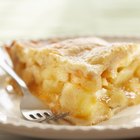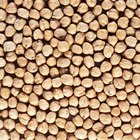
You may be able to use bread flour as a thickener for sauce if you don't have any all-purpose flour, but it may not be the best choice. That's because bread flour has more protein and less starch than all-purpose flour, even though they're both made from wheat. Bread flour's composition might not adversely affect most thickening, but it could be a crucial difference if the sauce you're making requires a certain level of starch.
More Protein
Bread flour is made specifically to have more protein than all-purpose flour. More protein gives the flour more ability to make gluten, the stretchy strands that result when flour is mixed with water. Those strands, also called the gluten network, are essential to creating lift in bread because the network captures the carbon dioxide bubbles created by yeast fermentation. It's those bubbles that cause the dough to expand, so making more of a "net" to catch the gas means higher, lighter bread.
Less Starch
The extra proteins that make bread flour so perfect for bread work against it as a thickening agent. Bread flour has less starch, and starch is the key ingredient for thickening sauces, gravies and pie fillings. Flour is made mostly of tiny starch granules compacted into little microscopic balls. When starches are moistened and heated in cooking, they take in water and swell up. That's what happens when you see noodles expand during cooking.
Heated Starches Gel with Liquid
When the cooking heat rises above 126 degrees Fahrenheit, starches begin to burst open and release tiny chains of molecules. As the heat rises, these free starches connect themselves into a spongy mesh that combines with liquid to form a gel. That's what causes sauces to thicken. The more starch in the flour, the easier the sauce will thicken. And the more flour you use, the thicker the sauce will be.
Mix Flour with Fat
Flour works well to thicken stews, gumbos and gravies, even the lower-starch bread flour version. Flour works best when it's first mixed with some fat, usually by combining flour with fat or drippings from meat or poultry. A mixture made with flour and fat, typically butter, is called a roux. If you're trying to keep the fat content in the dish low, mix flour with water and add that slurry to the sauce or gravy. Cook it just long enough to thoroughly dissolve, or the sauce will have a raw, starchy taste. Don't overcook it, though, as the sauce will thin out again.
Related Articles

Can You Use Bread Flour Instead of ...

How to Bake With Besan Flour

Can I Use Baking Powder to Thicken ...

Can I Substitute Bleached for ...

Differences Between Tapioca Starch and ...

Can You Make Dumplings With Corn Starch?

How to Make Bread Chewy
Can You Substitute Cornstarch for Flour?
What Is the Difference Between Cake ...

What Can I Substitute for Cornstarch?

Bread Flour vs. Cake Flour in Sponge ...

Can You Use Konjac Flour in Baking?

How to Substitute Potato Starch for ...

How to Roast Chickpea Flour

What Happens When Vinegar & Yeast Are ...

What Additives Are in Flour?

What Is a Synthetic Polyester Fabric?

How to Make Simple Homemade Gravy

How to Add Gluten to All-Purpose Flour

What Are Fire Resistant Clothes Made Of?
References
Resources
Writer Bio
Cynthia B. Astle is a longtime journalist who has written on practically every topic of human interest for newspapers such as the "United Methodist Reporter," magazines including "Response," "Arts Ministry" and the "Progressive Christian" and websites such as Darkwood Brew and United Methodist Insight. She was also a food editor and restaurant reviewer for the "Clearwater Sun."
Photo Credits
Jupiterimages/liquidlibrary/Getty Images